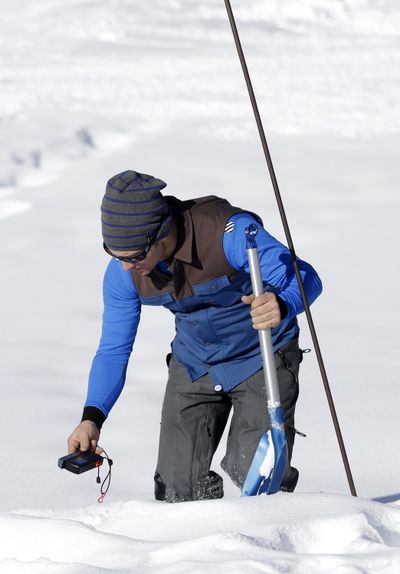Technology improves avalanche gear for backcountry skiers

SALT LAKE CITY – As outdoor recreation companies increasingly cater to skiers and snowboarders who like to venture beyond the groomed slopes at ski resorts and tackle backcountry terrain, they’ve put a special emphasis on gear and equipment to keep people safe in case of avalanches.
At this winter’s Outdoor Retailer show in Salt Lake City – which draws an estimated 22,000 people – the latest in rescue beacons, air bags and snow probes were on display.
Evolving technology and more research is driving the improved products, said Bruce Tremper, director of the Forest Service Utah Avalanche Center. He warns that the gear doesn’t make a person invincible. Backcountry skiers need to study avalanche-risk reports and weather forecasts and gauge the terrain, and newbies should take classes for safety tips.
Even all that preparation isn’t always enough to avoid getting caught in fast-moving avalanches.
“This does not replace good thinking, sound judgment in the backcountry, but it does stack the odds in your favor,” said John Dicuollo, spokesman for Salt Lake City-based Black Diamond, which unveiled a new air bag system this year.
Here’s a look at some of the latest in avalanche safety equipment:
Air bags
Air bags are designed to give backcountry skiers a fighting chance to stay afloat in an avalanche. A skier pulls the trigger on his front strap, activating a device to send air into the air bag that inflates like a large pillow.
“It makes you a bigger object,” said Bruce Edgerly, vice president of marketing and sales with BCA, a Boulder, Colorado-based company. “In an avalanche, the biggest objects, like the biggest pieces of debris, end up on the surface.”
BCA’s air bag pack uses a compressed air cylinder and costs $500, plus another $175 for the compressed air cylinder. The cylinder can only be used once, and then must be refilled for $10.
Black Diamond is selling a new air bag this week that uses a rechargeable, battery-powered fan to inflate the bag in a system called the “Jetforce Avalanche Airbag.” The system, which sells for $1,275, allows skiers to inflate the air bag four times per charge. The system also is allowed on airplanes, whereas the compressed air cylinders used in most packs are banned.
The North Face is unveiling a dual air bag system called the “Modulator ABS” that can be attached to any backpack. It costs $999.
The use of air bags gained extra steam after professional free style skier Elyse Saugstad survived an avalanche in Washington in 2012, which killed three people. She credited the air bag she used for saving her life.
Beacons
Transmitter devices worn by skiers have long been a must-have for backcountry skiers, allowing everyone in a group to be able to find each other in case of an avalanche. But emerging technology has made the devices easier to use and more reliable, and it has increased the range at which someone can be found.
The new beacons are digital devices that have screens that show an arrow and the estimated distance to a person. They range in price from about $150 to nearly $500.
Arva, which makes its beacons in France, sells a device called the “Neo” that can find somebody buried in snow nearly 200 feet away.
Black Diamond introduced a line of ski pants this year that enable a person to keep their rescue beacon in their pocket, secured by a harness and no-drop tether, so they can more easily access it in an emergency.
Snow probes
Most probes – long, foldable sticks that resemble tent pieces – are used to punch the snow when rescuers believe they are close to where a person is buried.
They are usually as low-tech as can be, but Avatech, a Utah-based company started by a trio of MIT graduates, has developed a probe that has a small device on top that resembles a GPS or smartphone. When a person pushes the Ava probe into the snow, it gives a reading of the snowpack levels and sends that information to a program that is tracking snowpack around the world.
The probe is not designed for use in avalanche rescues, but rather as a proactive tool to help avalanche and other snow professionals make better decisions about navigating in avalanche terrain.
The SP1 probe costs $2,249, and it’s only being sold for now to large organizations such as ski resorts, avalanche centers and guide companies, said Brint Markle, Avatech co-founder and CEO. The company is developing a similar probe for the retail market, but it doesn’t have a launch date yet.